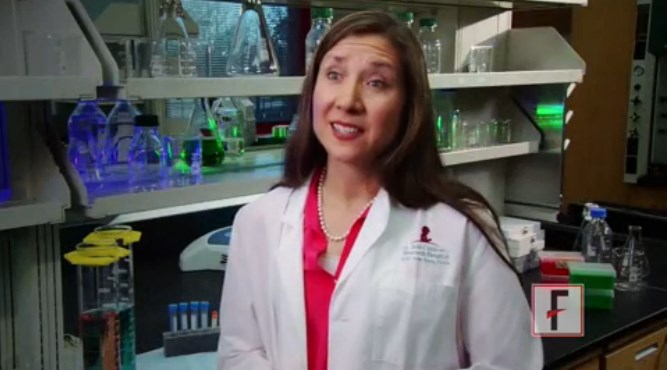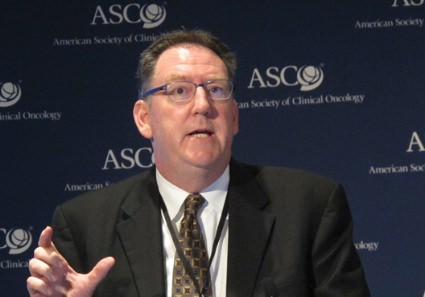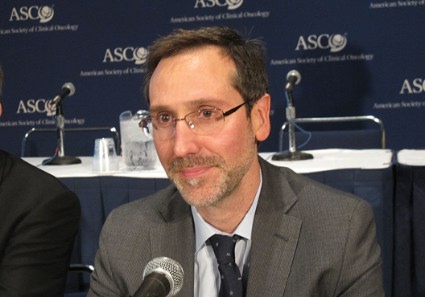User login
VIDEO: Search for genetic risk factors may improve vincristine therapy
Discovery of a genetic variation that may boost the risk of peripheral neuropathy for some cancer patients on vincristine therapy could lead to better treatment regimens for those patients.
Investigators uncovered the genetic variation in a study that analyzed DNA samples from 321 children with acute lymphoblastic leukemia who received standard vincristine therapy while participating in two prospective clinical trials (JAMA 2015 Feb. 24 [doi:10.1001/jama.2015.0894]).
William E. Evans, Pharm.D., and Kristine R. Crews, Pharm.D., both of St. Jude Children’s Research Hospital, Memphis, Tenn., discussed what spurred the search for genetic risk factors and what’s next for researchers looking to cut the chance of side effects associated with vincristine treatment in a video interview.
The video associated with this article is no longer available on this site. Please view all of our videos on the MDedge YouTube channel
Discovery of a genetic variation that may boost the risk of peripheral neuropathy for some cancer patients on vincristine therapy could lead to better treatment regimens for those patients.
Investigators uncovered the genetic variation in a study that analyzed DNA samples from 321 children with acute lymphoblastic leukemia who received standard vincristine therapy while participating in two prospective clinical trials (JAMA 2015 Feb. 24 [doi:10.1001/jama.2015.0894]).
William E. Evans, Pharm.D., and Kristine R. Crews, Pharm.D., both of St. Jude Children’s Research Hospital, Memphis, Tenn., discussed what spurred the search for genetic risk factors and what’s next for researchers looking to cut the chance of side effects associated with vincristine treatment in a video interview.
The video associated with this article is no longer available on this site. Please view all of our videos on the MDedge YouTube channel
Discovery of a genetic variation that may boost the risk of peripheral neuropathy for some cancer patients on vincristine therapy could lead to better treatment regimens for those patients.
Investigators uncovered the genetic variation in a study that analyzed DNA samples from 321 children with acute lymphoblastic leukemia who received standard vincristine therapy while participating in two prospective clinical trials (JAMA 2015 Feb. 24 [doi:10.1001/jama.2015.0894]).
William E. Evans, Pharm.D., and Kristine R. Crews, Pharm.D., both of St. Jude Children’s Research Hospital, Memphis, Tenn., discussed what spurred the search for genetic risk factors and what’s next for researchers looking to cut the chance of side effects associated with vincristine treatment in a video interview.
The video associated with this article is no longer available on this site. Please view all of our videos on the MDedge YouTube channel
FROM JAMA
VIDEO: Advanced melanoma on brink of immunotherapy ‘revolution’
CHICAGO – Advanced melanoma therapy – a field notorious for offering patients few drugs and little chance of survival – may be on the brink of an extraordinary transformation.
"There’s truly a revolution going in the immunotherapy of melanoma," explained Dr. Steven O’Day of the Beverly Hills (Calif.) Cancer Center.
In a video interview at the annual meeting of the American Society for Clinical Oncology, Dr. O’Day reviews the rapid developments in melanoma treatment options and the shift from a "nuclear bomb" approach to a more-targeted "cruise missile" mindset. He also highlights the parallels between the exceptional advances made in childhood leukemia treatment and new melanoma treatments such as ipilimumab and PD-1 inhibitors, and he discusses the new drugs’ ability to overcome a phenomenon that often defeats chemotherapy: cancer cell resistance.
CHICAGO – Advanced melanoma therapy – a field notorious for offering patients few drugs and little chance of survival – may be on the brink of an extraordinary transformation.
"There’s truly a revolution going in the immunotherapy of melanoma," explained Dr. Steven O’Day of the Beverly Hills (Calif.) Cancer Center.
In a video interview at the annual meeting of the American Society for Clinical Oncology, Dr. O’Day reviews the rapid developments in melanoma treatment options and the shift from a "nuclear bomb" approach to a more-targeted "cruise missile" mindset. He also highlights the parallels between the exceptional advances made in childhood leukemia treatment and new melanoma treatments such as ipilimumab and PD-1 inhibitors, and he discusses the new drugs’ ability to overcome a phenomenon that often defeats chemotherapy: cancer cell resistance.
CHICAGO – Advanced melanoma therapy – a field notorious for offering patients few drugs and little chance of survival – may be on the brink of an extraordinary transformation.
"There’s truly a revolution going in the immunotherapy of melanoma," explained Dr. Steven O’Day of the Beverly Hills (Calif.) Cancer Center.
In a video interview at the annual meeting of the American Society for Clinical Oncology, Dr. O’Day reviews the rapid developments in melanoma treatment options and the shift from a "nuclear bomb" approach to a more-targeted "cruise missile" mindset. He also highlights the parallels between the exceptional advances made in childhood leukemia treatment and new melanoma treatments such as ipilimumab and PD-1 inhibitors, and he discusses the new drugs’ ability to overcome a phenomenon that often defeats chemotherapy: cancer cell resistance.
AT THE ASCO ANNUAL MEETING 2014
VIDEO: Pembrolizumab may herald new hope in advanced melanoma
CHICAGO – Results from a phase I study of investigational PD-1 antibody pembrolizumab may point the way toward higher treatment response rates and less toxicity in patients with advanced metastatic melanoma.
Of 411 patients who took pembrolizumab, 1-year overall survival was 69%, and 88% of patients who had a treatment response continued to have a response at 1 year, reported Dr. Antoni Ribas, professor of medicine at the University of California, Los Angeles.
In a video interview at the annual meeting of the American Society for Clinical Oncology, Dr. Ribas discussed the study results and explained how PD-1 antibodies help the immune system recognize and mount a more potent T-cell–mediated defense against melanoma.
The video associated with this article is no longer available on this site. Please view all of our videos on the MDedge YouTube channel
CHICAGO – Results from a phase I study of investigational PD-1 antibody pembrolizumab may point the way toward higher treatment response rates and less toxicity in patients with advanced metastatic melanoma.
Of 411 patients who took pembrolizumab, 1-year overall survival was 69%, and 88% of patients who had a treatment response continued to have a response at 1 year, reported Dr. Antoni Ribas, professor of medicine at the University of California, Los Angeles.
In a video interview at the annual meeting of the American Society for Clinical Oncology, Dr. Ribas discussed the study results and explained how PD-1 antibodies help the immune system recognize and mount a more potent T-cell–mediated defense against melanoma.
The video associated with this article is no longer available on this site. Please view all of our videos on the MDedge YouTube channel
CHICAGO – Results from a phase I study of investigational PD-1 antibody pembrolizumab may point the way toward higher treatment response rates and less toxicity in patients with advanced metastatic melanoma.
Of 411 patients who took pembrolizumab, 1-year overall survival was 69%, and 88% of patients who had a treatment response continued to have a response at 1 year, reported Dr. Antoni Ribas, professor of medicine at the University of California, Los Angeles.
In a video interview at the annual meeting of the American Society for Clinical Oncology, Dr. Ribas discussed the study results and explained how PD-1 antibodies help the immune system recognize and mount a more potent T-cell–mediated defense against melanoma.
The video associated with this article is no longer available on this site. Please view all of our videos on the MDedge YouTube channel
AT THE ASCO ANNUAL MEETING 2014


